Abstract
Special attention of scientists is focused on rare plant species that often grow in extreme natural and climatic conditions, under the negative influence of anthropogenic factors. (Thunb.) Makino is one of the rarest species of vascular plants on the globe, it has the status of a protected species and is listed in the Red books. The main range of this species is located in Eastern China, but it was described as a new species for science from collections from Japan. In Russia, grows on the Northern border of its range. The article provides information about the distribution of, its findings in the Russian Amur region, habitat features, cenotic and ecological conditions of growth, as well as issues of conservation of the species. In the left-Bank part of the Russian Amur region, our findings are the first and only. They are confined to isolated low-mountain formations of the middle Amur lowland-the Dolgusha and Ostryak mountains. The habitat of the species is characterized by a stony substrate with a small amount of soil and moisture. However, on mount Ostryak, plants are noted under the canopy of sparse broad-leaved forest with a predominance of Mongolian oak Fisch. ex Ledeb. In the study region it has not only vegetative, but also generative organs, it successfully bears fruit and reproduces. The findings of this species in the Amur region have expanded scientific information about its geographical distribution and Northern border.
Keywords: Ampelopsis japonica (Thunb) Makino, floristic finds, Amur, Russia
Introduction
Rare and plant species in need of protection can be divided into two main groups: naturally rare species that are potentially vulnerable due to their biological characteristics and species that are in danger of extinction or that reduce their number and habitat due to anthropogenic impact. Among the biological characteristics of these species, the following features can be distinguished: low abundance, small area of distribution, low density, low ecological valence, low rate of population reproduction, and negative attitude to human presence. Rare and endangered species of vascular plants is one of the most fragile and very important parts of biodiversity that form the basis of the integrity of ecosystems and the biosphere as a whole. They have great scientific, educational, ethical and aesthetic significance. It is necessary to have as much information as possible about habitats, the phytocenoses in which they grow. The global scale of the problem of conservation of rare species of animals and plants is determined by the recognition of the importance of preserving biological diversity as a guarantee of sustainable development not only of the Russian Federation, but of all countries in the world. In this context, biodiversity must be considered as a basic natural asset, the loss of which can lead to the degradation of a number of ecosystem services, which will damage the well-being of people. Special programs are being developed to preserve rare plant species. For example, China has developed a PES program (2011-2015) aimed at priority conservation of 120 plant species (Yang et al., 2020). Scientists pay considerable attention to the issues of maintaining the Red books of regions and countries, the impact of global climate change on plants, modeling the distribution of species, and preventing future invasions of species (Tang et al., 2019; Volis & Deng, 2020).
Problem Statement
Thus, issues of biodiversity loss have gone beyond the traditional debate about the importance of wildlife conservation, taking a significant place in discussions about human well-being, sustainability of the current lifestyle, including consumption patterns.
Research Questions
Among the rare families, a special place is occupied by Grape varieties with various lianas, which include(Thunb.) Makino; This is reflected in the scientific literature (Hu & Li, 2015). (Thunb.) Makino – a rare species of vines of the genus Ampelopsis, which needs special protection. It belongs to the Angiosperms department, Dicotyledoneae class, Vitaceae family. This is a perennial vine 2-3 meters long. Some authors believe that this is a grassy vine (Vascular plants ... 1989), and others call it a woody vine. In our region, the plant blooms in June. A fruit has one - three seeds. Usually they ripen in September.
was described in Japan (Ohwi, 1965). The species is common in China (Guangdong, Hebei, Henan, Hubei, Hunan, Jiangsu, Jiangxi, Jilin, Liaoning, Shanxi, Sichuan, Liaoning), Korea, Japan (Clavis plantarum ..., 1995; Lee, 1996). In Japan, the species is currently cultivated mainly for medicinal purposes, despite the fact that it was described from the territory of this country (Ohwi, 1965). The species is absent in the Chinese province of Heilongjiang bordering the Russian Amur region. In Russia, the species grows on the northeastern border of the area (Harkevich & Kachura, 1981) (Figure 1).
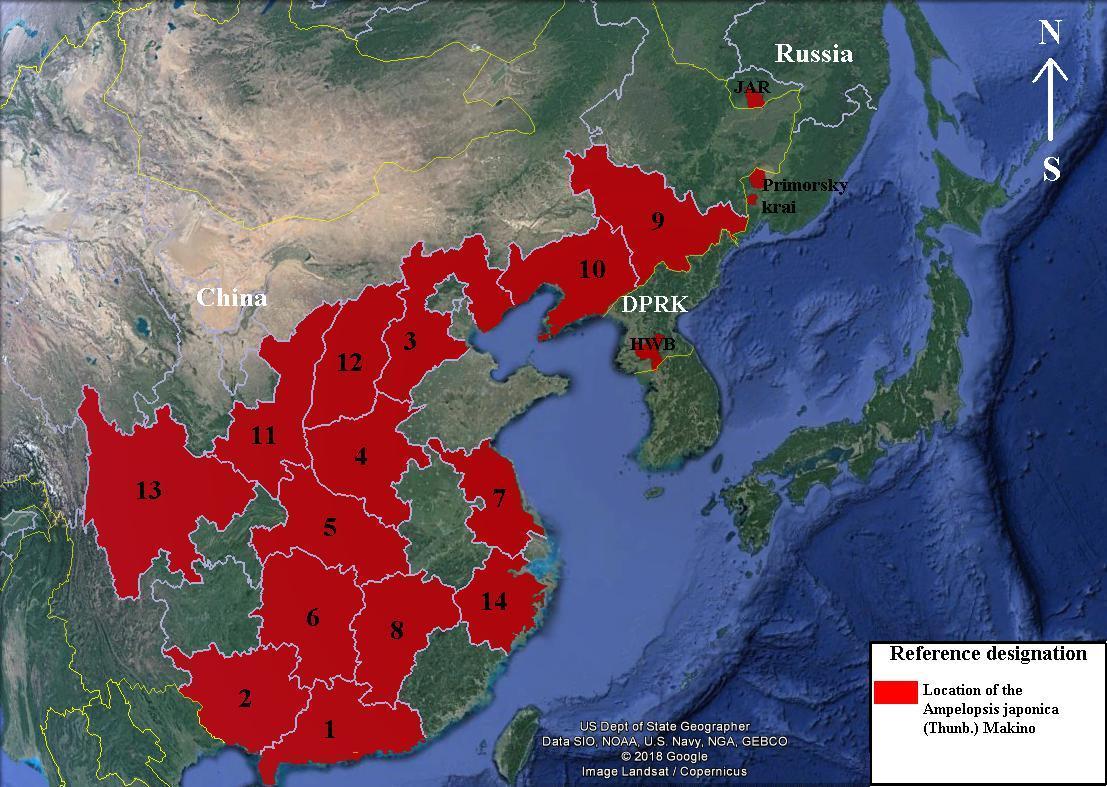
Purpose of the Study
The goal of this work is to provide up-to-date original data on floristic finds of and clarify information about the northeastern border of the area.
Research Methods
The research material: herbaria collected on the left bank of the Russian Amur region in 2002 and 2008, results of geobotanical descriptions of trial plots of forest vegetation , analysis of the scientific literature, determinants for vascular plants (Clavis plantarum ..., 1995; Lee, 1996) and herbaria (LE, MHA, VLA, NS, PE).
Findings
Before 2003, in Russia was discovered only in a few locations in the Khankaisk district of the Primorsky region south-west, in the Razdolnaya River valley. In the Komissarovki River valley the species occurred but in an oppressed state. In July 23, 2002, T.A. Rubtsova and her colleagues discovered creepers (Rubcova et al., 2003) (Figure 02) during their field work in the Middle Amur region of Russia, in the Jewish autonomous region (Figure 03, 04) near the village of Ventselevo, Leninsky District, eight kilometers from the Amur River on the low Mountain Dolgusha (47°48'00,4" с.ш., 131°55'59,4" в.д.).
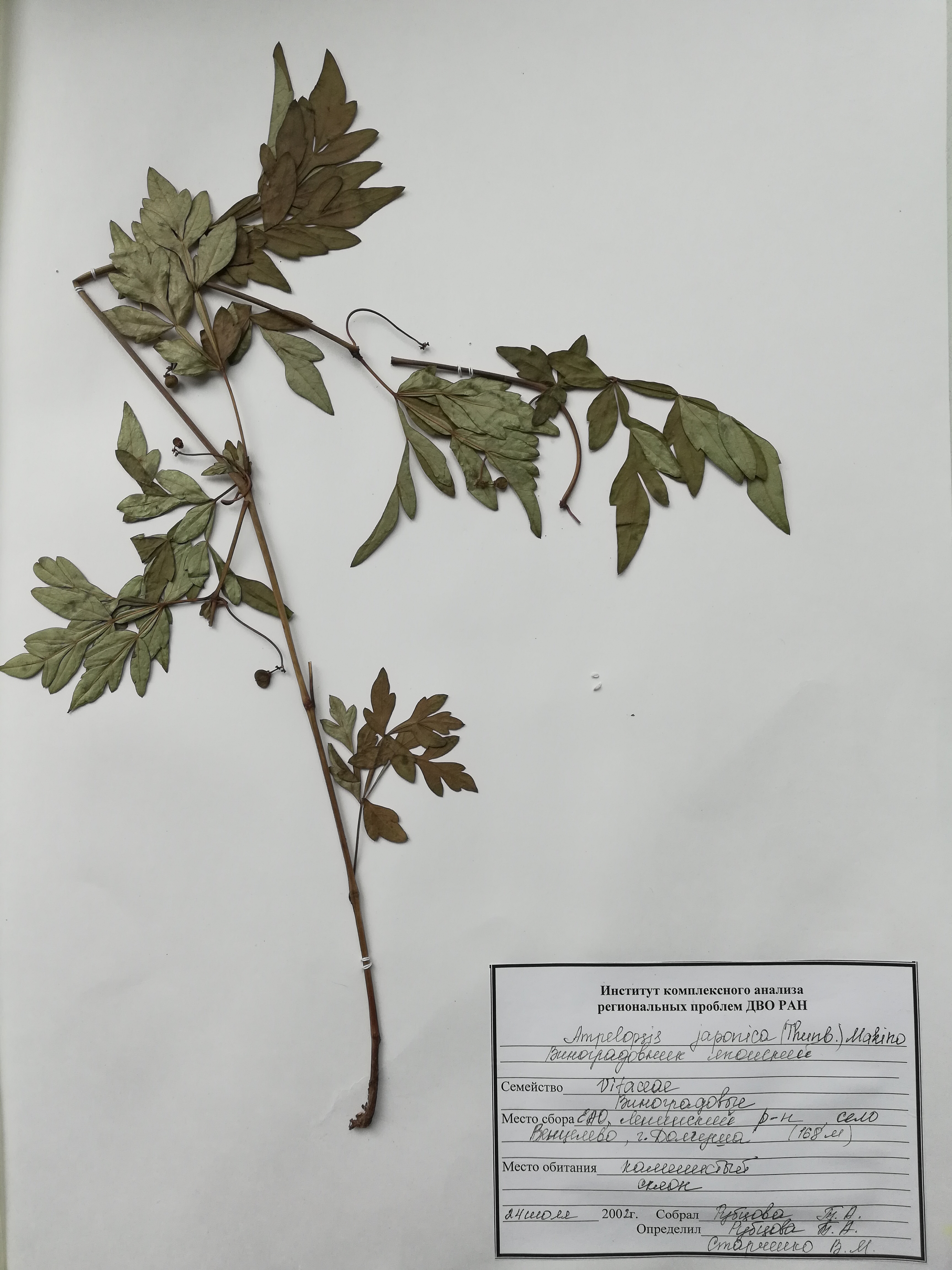
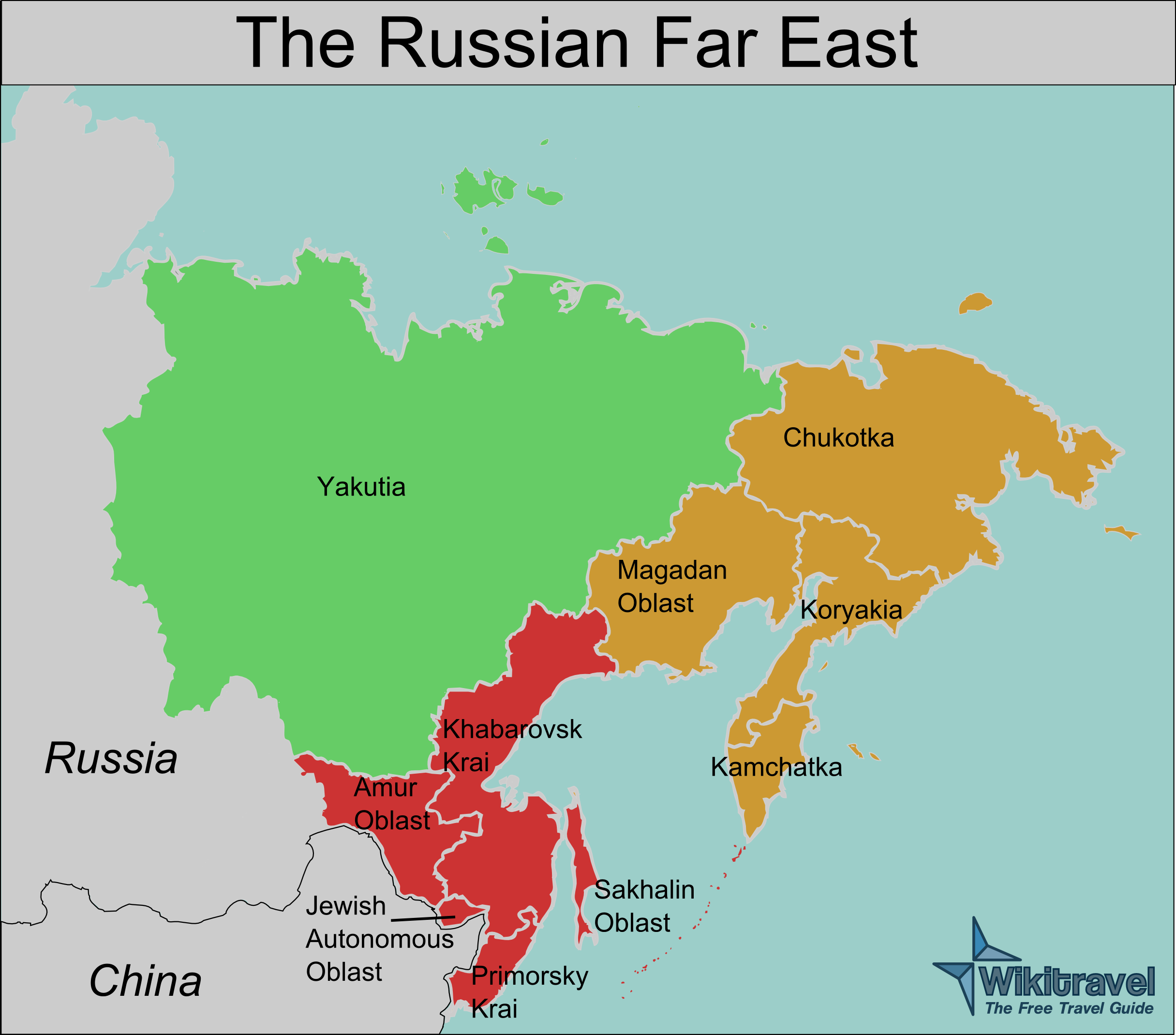
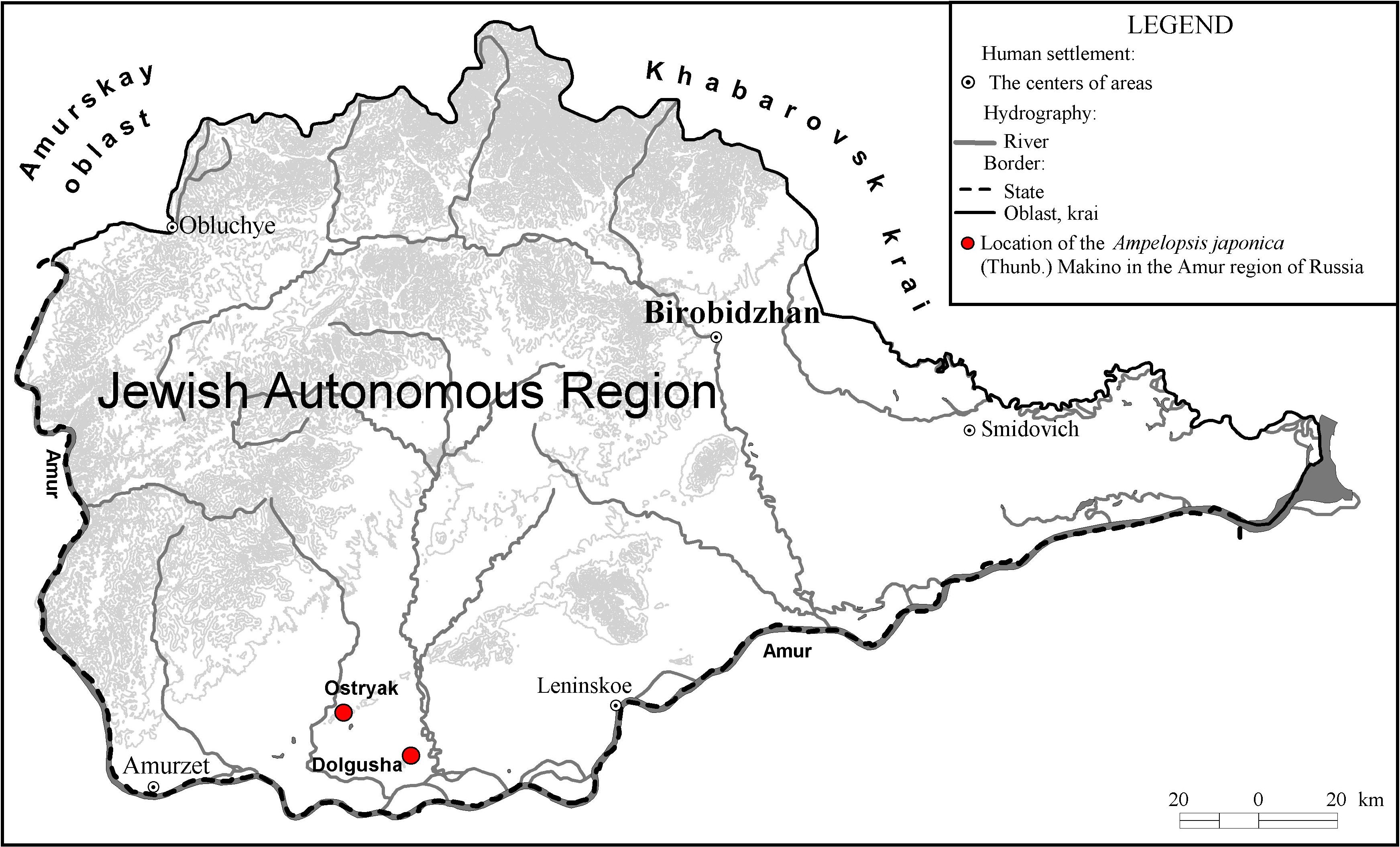
The Mount Dolgusha stretches from southwest to northeast for 2 kilometers; its maximum height is 168 meters (Figure 05).
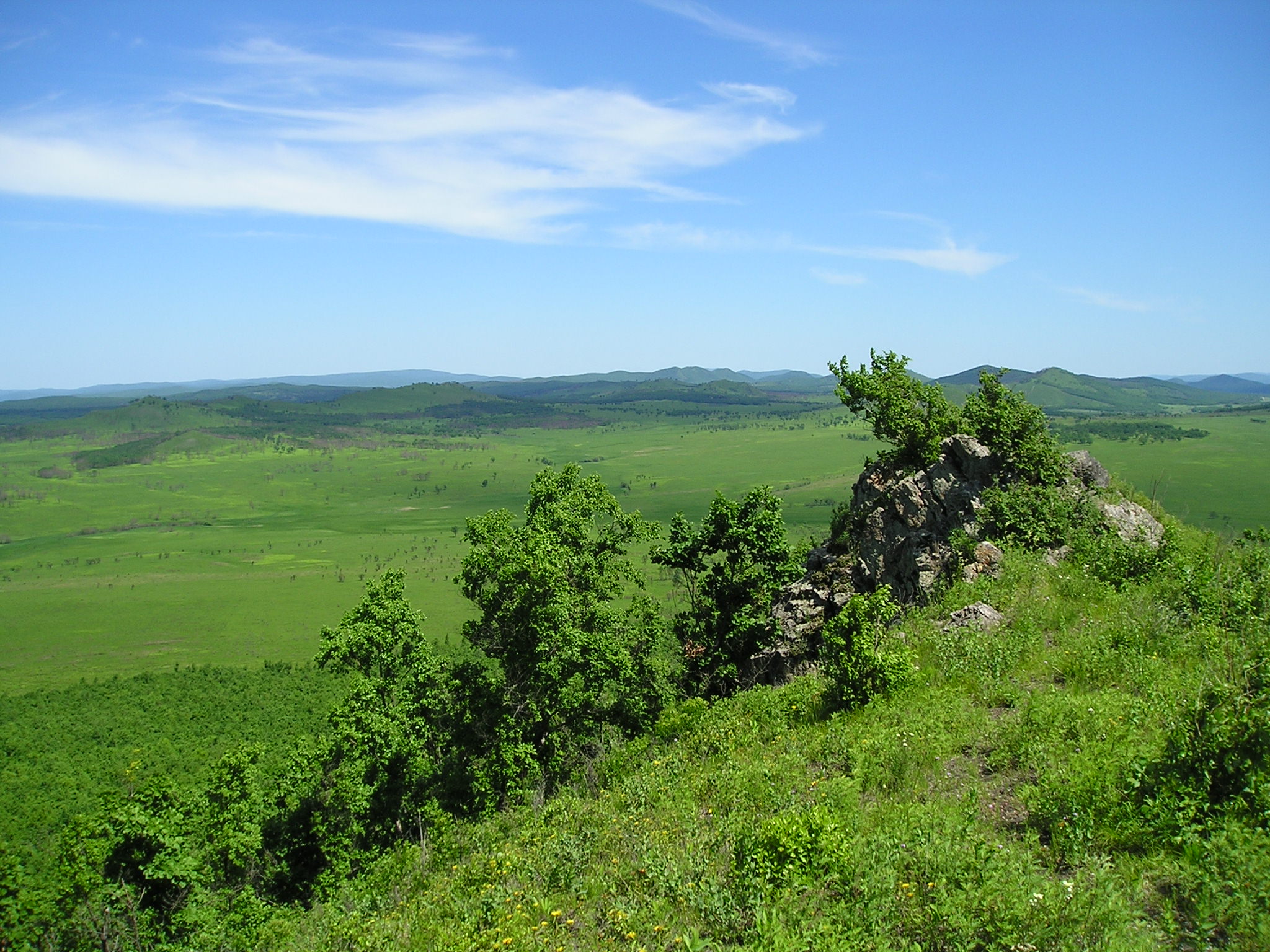
The plant was found on the northeastern slopes, mainly in the middle part, on dry stony spots among herb-shrub groups without tree stand, on rocky placers. The following of the herbaceous plants are common there: (Turcz.) Maxim., Pall., Pall.,(L.) Patakia sci mori. ex Link., Web. ex Stechm. On the mountaintop and its opposite side, there grow undersized broad-leaved species of trees: Fisch. ex Ledeb. (projective cover up to 60%, average height 9 meters, average diameter 20 centimeters), single Rupr., (Rehd.) Sarg., Pall. In the undergrowth - Turcz., Corylus heterophylla Fisch. ex Trautv. (projective cover - 50% and 30%, respectively).
The local population of is in a favorable condition; the plants bloom and bear fruit (Figure 06).
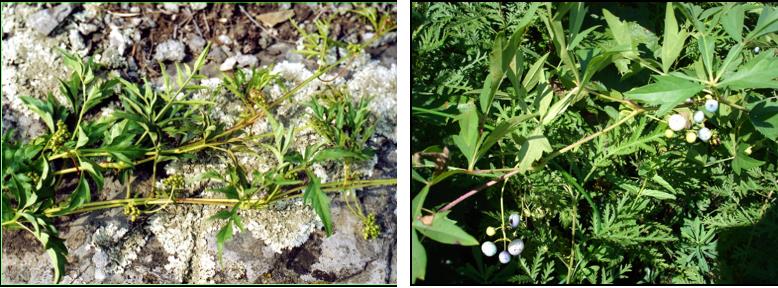
The species was new to the Russian Amur region. Six years later, we found this species at the lower part of the eastern slope on the isolated Ridge Ostryak (47°53'053,9" с.ш., 131°44'46,2" в.д.; absolute height 333 meters), 20 kilometers northwest of the Dolgusha Mountain, on rocky substrate in an oak sparse forest, but not on an open treeless slope like on the Mount Dolgushа (Figure 4, 7).
The Mountain Dolgushа and the Ridge Ostryak are the island - isolated mountain formations located on the Central Amur Lowland.
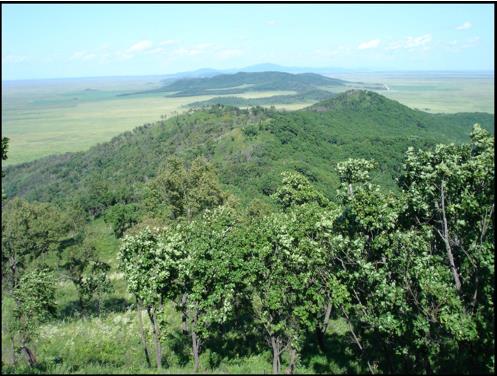
Thus, at present, we know the two points on the Amur left bank where grows in different coenotic conditions.
In the paper ”Flora of Manchuria”, V.L. Komarov (Komarov, 1950) cited this species as occurring in some regions of Northeast China and indicated its growth in the Mulinhe River (a tributary of the Ussuri River) and the Suifun (Razdolnaya) River valleys. To E.M. Murzaev (Murzaev, 1955), these forest-steppe areas in China extend up to the borders of the Russian Far East along the banks of the Amur, Ussuri, Razdolnaya rivers, and Lake Khanka. The disjunctive nature of the forest-steppe in Manchuria explains the disjunctive habitat within the Russian Far East. This is also characteristic of some steppe species whose habitats are in the territory of China and Korea. The finding of on the Middle Amur left-bank region confirms the disjunctive distribution of this species. The nearest localities of this species in Russia are about 400 km, in the Primorsky territory.
Our observations show that the plant prefers dry rocky slopes of hills with shrubs, river terraces, rocky placers, sparse oak trees. In relation to moisture, the species belongs to the ecological group of xerophytes, and geographically it belongs to the Amur-Japanese nemoral species (Rubcova, 2017).
The main limiting factors for are annual spring fires, the lack of stable snow cover, and strong winds.
In Russia, is the protected species included in the Russian Red Book of the Russian Federation (2008) with the protection category 1 – the disappearing species. In addition, the species is included in the Red Book of the Primorsky territory with the status EN – the endangered species. In the Red Book of the Jewish autonomous region, the species has the category 1 – the disappearing species on the northeastern border of the area. On the new list of regional plants in need of protection, the has the category 3d - the species with a limited habitat, as a part of its habitat is in Russia. Unlike in the countries of East Asia, this plant is not used for practical purposes in Russia; it is protected. (Kim et al., 2007). To preserve, a regional protected area was founded in the Jewish Autonomous region – the reserve “Vinogradovnik”. The Ridge Ostryak is also located within the reserve “Bidzhanskie Peaks” (Figure 08).
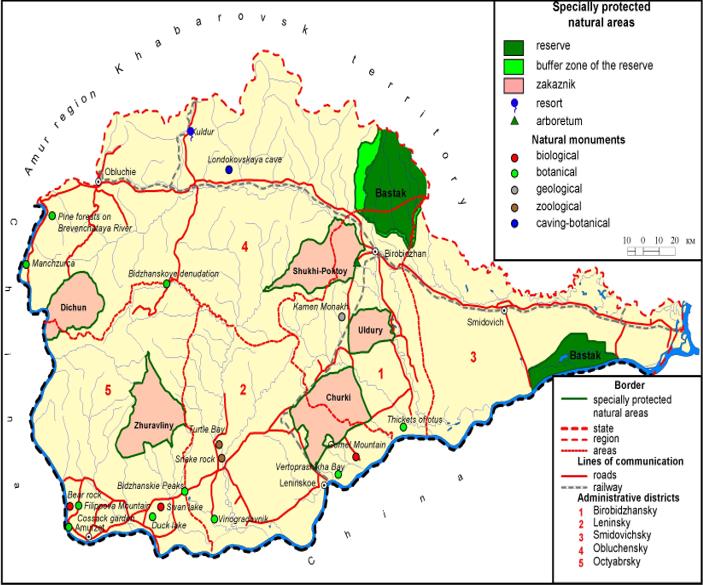
Conclusion
Ampelopsis japonica
References
Clavis plantarum Chinae boreali-orientalis. (1995). Еdited by Fu Peiyun. Science Press.
Harkevich, S. S., & Kachura, N. N. (1981). Redkie vidy rastenij sovetskogo Dal'nego Vostoka i ih ohrana [Rare plant species of the Soviet Far East and their protection]. Nauka. [in Russ.].
Hu, L., & Li, M. (2015). Diversity and Distribution of Climbing Plants in Eurasia and North Africa. In N. Parthasarathy (Ed.) Вiodiversity of lianas: 5 (Sustainable Development and Biodiversity) (pp. 57-79). Springer International Publishing AG.
Kim, I. H., Umezawa, M., Kawahara, N., & Goda, Y. (2007). The constituents of the roots of Ampelopsis japonica. Journal of Natural Medicines, 61(2), 224-225.
Komarov, V. L. (1950). Izbrannye sochinenija [Selected works]. Izdatel'stvo Akademii nauk SSSR. [in Russ.].
Lee, T. B. (1996). Illustrated Flora of Korea. Academy Publishing Co. Ltd.
Murzaev, Je. M. (1955). Severo-Vostochnyj Kitaj. Fiziko-geograficheskoe opisanie [North-Eastern China. Physical and geographical description]. Izdatel'stvo Akademii nauk SSSR. [in Russ.].
Ohwi, J. (1965). Flora of Japan. Smithsonian Institution, D.C.
Rubcova, T. A. (2017). Flora Evrejskoj avtonomnoj oblasti [Flora of the Jewish Autonomous region]. Antar. [in Russ.].
Rubcova, T. A., Antonova, L. A., & Starchenko, V. M. (2003). Novye dlja flory Evrejskoj avtonomnoj oblasti vidy sosudistyh rastenij [Vascular plant species new to the flora of the Jewish Autonomous region]. Botanical journal, 88(10), 123-127. [in Russ.].
Tang, L., Wang, R., He, K. S., Shi, C., Yang, T., Yaping, H., Zheng, P., & Shi, F. (2019). Throwing light on dark diversity of vascular plants in China: predicting the distribution of dark and threatened species under global climate change. PeerJ 7:e6731. DOI:
Volis, S., & Deng, T. (2020). Importance of a single population demographic census as a first step of threatened species conservation planning. Biodiversity and conservation, 29(2), 527-543.
Yang, J., Cai, L., Liu, D., Chen, G., Gratzfeld, J., & Sun, W. (2020). China's conservation program on Plant Species with Extremely Small Populations (PSESP): Progress and perspectives. Biological conservation, 244. DOI:
Copyright information

This work is licensed under a Creative Commons Attribution-NonCommercial-NoDerivatives 4.0 International License.
About this article
Publication Date
21 June 2021
Article Doi
eBook ISBN
978-1-80296-110-2
Publisher
European Publisher
Volume
111
Print ISBN (optional)
-
Edition Number
1st Edition
Pages
1-1168
Subjects
Social sciences, education and psychology, technology and education, economics and law, interdisciplinary sciences
Cite this article as:
Rubtsova, T. (2021). Finds Of Ampelopsis Japonica (Thunb.) Makino In The Russian Amur Region. In N. G. Bogachenko (Ed.), Amurcon 2020: International Scientific Conference, vol 111. European Proceedings of Social and Behavioural Sciences (pp. 824-831). European Publisher. https://doi.org/10.15405/epsbs.2021.06.03.109

